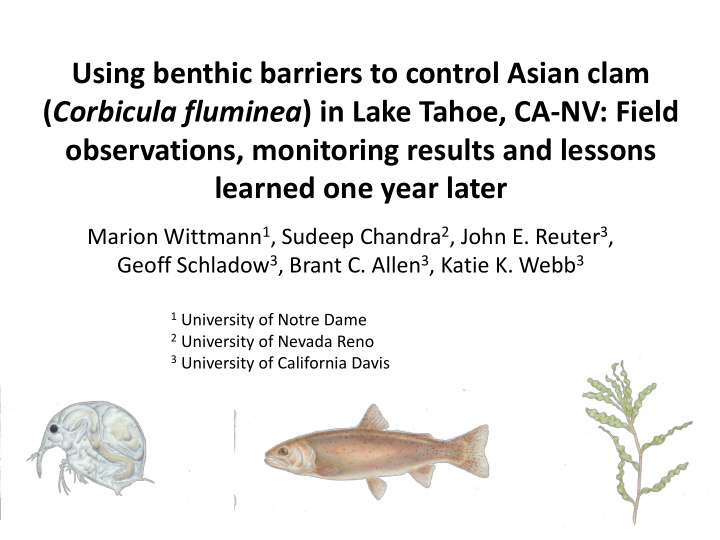



Using benthic barriers to control Asian clam ( Corbicula fluminea ) in Lake Tahoe, CA-NV: Field observations, monitoring results and lessons learned one year later Marion Wittmann 1 , Sudeep Chandra 2 , John E. Reuter 3 , Geoff Schladow 3 , Brant C. Allen 3 , Katie K. Webb 3 1 University of Notre Dame 2 University of Nevada Reno 3 University of California Davis
League to Save Lake Tahoe Newsletter, Spring 2003 Large populations discovered in Large-scale Nevada Beach, Barrier application S/E Lake Tahoe Lower Lake Tahoe Truckee River Rapid response, experimentation, Lower Truckee River Monitoring tributaries surveying and results Timber Cove, Lake Tahoe Emerald Bay discovery
Asian clam ( Corbicula fluminea ) association with filamentous algal blooms and shell deposition attracted public attention and instigated rapid response ↑ Sediment porewater SRP, NH 4 , Ca 2+ ↑ Filamentous algae Cladophor glomerata , Spirogyra sp., Zygnema sp. ↓ Aesthetic values
Filter feeding invasive species can disrupt food webs in ecosystems in which they establish: Benthic production can account for 10 – 90% of carbon in lacustrine fish populations (Vander Zanden et al. 2011) Game fish Juveniles Forage fish Zooplankton Benthic macroinvertebrates Phytoplankton Filter feeding Nutrients invasive species
Benthic species in the Tahoe ecosystem: Potentially impacted by invasive species • Oligochaeta (worms) • Chironomidae (midges, flies) • Trichoptera (caddis flies) • Gastropoda (snails) • Pisidium spp (native clams) • Amphipoda (crustaceans) • Crayfish
Benthic community composition in Lake Tahoe 100% Proportion of benthic macroinvertebrate Other taxa Pisidium spp. community C. fluminea 50% Gastropoda Oligochaeta Chironomidae Amphipoda 0% Marla Bay Lakeside
Asian clams are habitat limited when dissolved oxygen concentrations are low: Artificially induce hypoxia using EPDM pondliner results in 100% mortality after 28 days Live Dead
Two sites were selected to place bottom barriers in Lake Tahoe: Marla Bay, NV and near Lakeside Marina, CA
Collaborated with agencies and stakeholders to experiment with a large scale bottom barrier deployment: total 1 acre applied in Lake Tahoe 30 m 60 m Aerial photo: ½ acre of EPDM pondliner in Barrier application in regulated environment Lake Tahoe, NV included involvement from multiple agencies, science teams and media
And then we monitored….
Over 40 individuals from universities, agencies, non-profit organizations and homeowners associations contributed to the field effort for Asian clam in Lake Tahoe
Results from 1 year period of monitoring bottom barrier treatment plots: Asian clam population densities over 90% reduced 5000 5000 Control Barrier 4000 4000 no m 2 3000 3000 Abundance 2000 2000 1000 1000 0 0 Prior to Treatment Barrier removal 3 Months post removal 8 Months post removal 12 Months post removal Jun 2010 Nov 2010 Feb 2011 June 2011 Nov 2011 Wittmann et al. 2012 Environmental Management
Chironomids are impacted immediately after removal of barriers, greater abundances than control conditions after 1 year 5000 5000 Control no m 2 Barrier 3000 3000 Abundance 1000 1000 0 0 Prior to Treatment Barrier removal 3 Months post removal 8 Months post removal 12 Months post removal Oligochaeta are impacted immediately after removal (>99% reduction) Jun 2010 Nov 2010 Feb 2011 June 2011 Nov 2011 5000 5000 Oligochaetes and populations remain different after 1 year Control no m 2 Barrier 3000 3000 Abundance 1000 1000 0 0 Prior to Treatment Barrier removal 3 Months post removal 8 Months post removal 12 Months post removal Jun 2010 Nov 2010 Feb 2011 June 2011 Nov 2011
Monitoring of suction removal sites: Asian clam, native Pea clam, total invertebrate abundance and diversity indices remain impacted after 450 days Wittmann et al. 2012 Aquatic Conservation
Alternative mechanisms for Asian clam mortality: Field experiment to look at the development of nutrient concentrations in bottom barrier conditions
Presence of Asian clam significantly introduces ammonium to the bottom barrier environment — potentially affecting mortality rates
Impact of management: Increased filamentous algal blooms in bottom barrier locations
Impact of management: Increased nonnative crayfish ( Pacifastacus leniusculus) in bottom barrier locations
Conclusion • EPDM bottom barriers can reduce dissolved oxygen concentrations in 3 – 5 days under specific conditions • Exposure to anoxic conditions for 28 days results in 99 – 100% Asian clam mortality • Native benthic macroinvertebrate populations are also experiencing mortality as a result of bottom barrier application • After 1 year, Asian clam population abundances in barrier plots are at approximately 9% of non-treatment areas • Recolonization patterns show shifts in relative abundances of native and non-native benthic macroinvertebrates • Management of Asian clams is impacting the benthic environment in the short term (up to 1 year period)
The management of invasive species establishment requires: • Rapid response • Understanding of impacts to ecosystem functioning • Knowledge of short term and long term impacts of management actions and associated costs • Comprehensive management plan • Coordination between science, management and policy
Acknowledgements • This research was supported by an agreement from the USDA Forest Service Pacific Southwest Research Station • This research was supported in part using funds provided by the Bureau of Land Management through the sale of public lands as authorized by the Southern Nevada Public Land Management Act, Clean up and Abatement funds from the Lahontan Regional Water Quality Control Board and License Plate Funds through the Nevada Division of State Lands
Recommend
More recommend